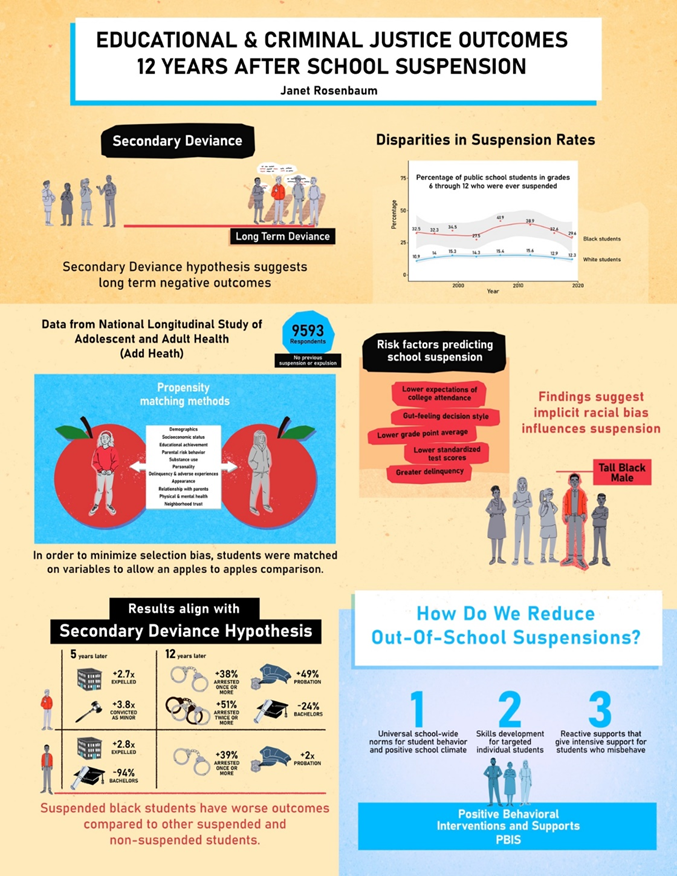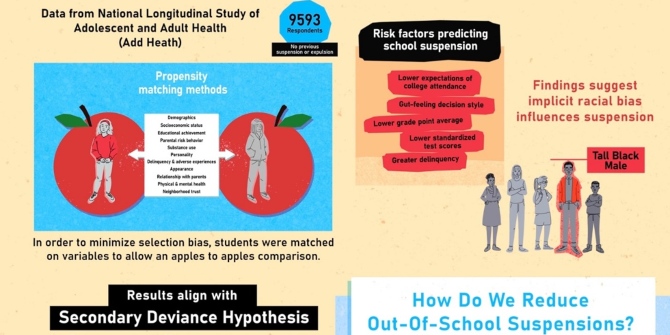 Evidence of the negative effects of school suspension has seen increasing efforts to reduce its use. In research on the long-term effects of school suspensions, Janet E. Rosenbaum finds that in the long term, suspended adolescents have lower college completion and higher criminal justice involvement rates, and that Black males were more likely to be suspended. She writes that the COVID-19 pandemic has presented an opportunity to reevaluate the role of suspension in schools and suggests how positive behavioral interventions and support can be used as a more constructive alternative.
Evidence of the negative effects of school suspension has seen increasing efforts to reduce its use. In research on the long-term effects of school suspensions, Janet E. Rosenbaum finds that in the long term, suspended adolescents have lower college completion and higher criminal justice involvement rates, and that Black males were more likely to be suspended. She writes that the COVID-19 pandemic has presented an opportunity to reevaluate the role of suspension in schools and suggests how positive behavioral interventions and support can be used as a more constructive alternative.
Evidence of the negative long-term effects of school suspension has spurred efforts in the United States to reduce school suspension at the federal, state, and local levels for more than a decade. These measures have been supported by the increased acceptance of the idea that harsh punishments such as suspension may be counterproductive and push students away from school (known as the secondary deviance hypothesis). At the same time, some parents and policymakers have become concerned that decreasing school suspension was risky and permissive, a view that led the Trump administration to rescind federal guidelines to improve school climate and decrease school suspension.
What are the long-term effects of suspension on school students?
The COVID-19 pandemic has presented an opportunity to reevaluate the role of suspension in schools. Remote schooling during the COVID-19 pandemic offered a nationwide reprieve from suspension because students were physically not in school buildings. Fewer student behaviors were observable by teachers and administrators, and fewer rules applied to student behaviors that occurred in their homes. In New York City, school suspension decreased by 99 percent during remote schooling during the early COVID-19 pandemic and decreased by 16 percent in the 2021-22 school year. Despite this benefit, COVID-19 has had otherwise negative effects on teachers and schools – about 20 percent of teachers reported having long Covid, a chronic illness – and these effects should be kept in mind.
To answer the question of the long-term effects of school suspension, I analyzed a nationally representative sample of US adolescents using a rigorous statistical technique. By comparing adolescents who were suspended with similar adolescents who were never suspended, I found that suspended adolescents have lower college completion and higher criminal justice involvement, lending support to the idea that suspensions push students away from school. Further, I found that each inch of height increased the chances of suspension for Black males, but for no other students, a finding that suggests the racist application of school discipline policies. My research and methodology are explained in the following video and infographic:
Helping schools to move beyond suspension
Alternative ways of thinking about discipline, such as positive behavioral interventions and supports (PBIS) can help schools transition from suspension. The PBIS framework has three levels: universal school-wide norms for student behavior and positive school climate are the primary prevention of misbehavior; individual skills development sessions targeting at-risk students are secondary prevention; and reactive supports that give intensive support for students who misbehave are tertiary prevention. Using a constructive approach such as PBIS in place of a punitive one has the benefits of reducing misbehavior and building students’ skills, reducing the need for approaches such as school suspension. The US Department of Education will support school districts in adopting PBIS, including sharing methods to reduce the burden on teachers such as peer-mediated approaches. However, adoption is uneven: only about a quarter of US schools have adopted PBIS, with lower uptake in rural areas.
Approaches such as PBIS require appropriate levels of staffing to intervene with at-risk students rather than pushing them out. Policymakers must support teachers and staff by resourcing schools to meet students’ needs, such as on-site school nurses and psychologists and appropriate ratios of guidance counselors; the more comprehensive approach of community schools has also demonstrated success in improving school climate and outcomes. Unfortunately, the COVID-19 pandemic has moved school staffing in the wrong direction: 61 percent of public schools reported in January 2022 that COVID-19 increased school staffing shortages, and to cope with staffing shortages, 62 percent of schools reported using non-teaching staff outside their normal duties. Staffing shortages may be due in part to long Covid, reported by 20 percent of teachers. The long Covid burden and safety concerns among teachers are likely to grow with increasing disease transmission as schools remove disease mitigation measures: in February 2022, 58 percent of schools required masks and in March 2022, only 22 percent of schools required masks. With all teachers at risk of COVID-19, even a 5% risk of long Covid will negatively impact the teaching labor force.
Supporting student mental health is particularly important during the continuing COVID-19 pandemic: a March 2022 survey found that 68 percent of US schools reported that staff had expressed moderate or extreme concerns about students’ mental health needs and 61 percent reported that parents had moderate or extreme concerns about students’ mental health. The Centers for Disease Control’s 2021 Adolescent Behavior and Experiences Survey found 44 percent of adolescents reported experiencing depressed mood for at least 2 weeks, compared with 37 percent of adolescents in the 2019 Youth Risk Behavior Survey.
Teachers also benefit from a more supportive approach
Fortunately, positive behavioral interventions and supports (PBIS) offers opportunities to promote teacher and staff wellness, an issue that the US PBIS Center highlights in the context of the ongoing COVID-19 pandemic. A five-part podcast by my colleagues Seth Gershenson of American University and Steve Holt of SUNY Albany about how schools can meet teachers’ mental health needs offers additional suggestions independent of the PBIS framework. Even before the pandemic, the recent cohort of teachers had worse mental health than an earlier cohort at the same ages, and by March 2022, 57 percent of school staff were moderately or extremely concerned about their own mental health. Long covid presents independent mental health challenges for affected teachers through new-onset mental illness.
Even as the pandemic created an opportunity for school discipline changes, it presents new challenges and highlights on-going ones that may complicate the transition from school suspension. Being aware of these challenges can help policymakers and school leadership anticipate and proactively address challenges, rather than using challenges as reasons for indefinite delay and inaction. My research suggests the need to find alternatives to suspension both for racial justice and for the futures of all students, issues that have been highlighted by the COVID-19 pandemic.
- This article is based on the paper ‘Educational and Criminal Justice Outcomes 12 Years After School Suspension’, in Youth & Society.
Please read our comments policy before commenting.
Note: This article gives the views of the author, and not the position of USAPP– American Politics and Policy, nor of the London School of Economics.
Shortened URL for this post: https://bit.ly/3zVnVt5
About the author
 Janet Rosenbaum – SUNY Downstate Health Sciences University
Janet Rosenbaum – SUNY Downstate Health Sciences University
Janet Rosenbaum is assistant professor of epidemiology in the Department of Epidemiology and Biostatistics, School of Public Health, SUNY Downstate Health Sciences University, Brooklyn, NY. Her research applies causal inference methods to study adolescents’ social determinants of health and unplanned pregnancy prevention.







